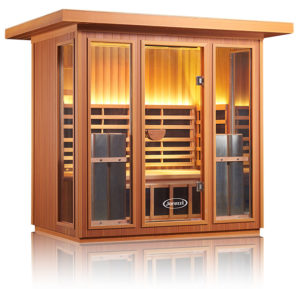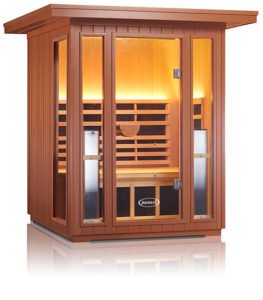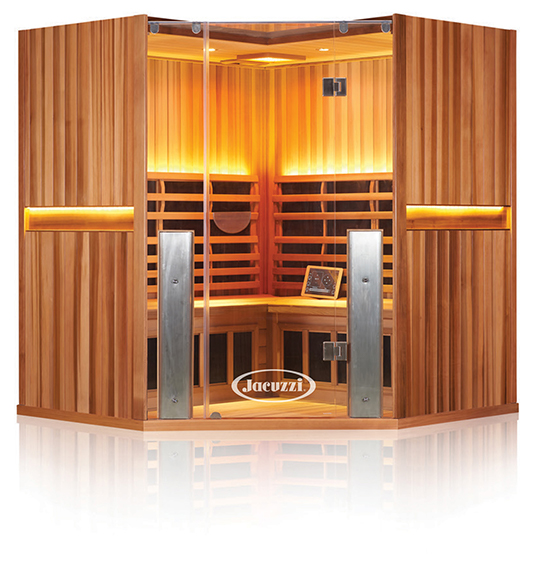Written by Christopher Kiggins
To read more about why you would want a full spectrum infrared sauna, click here.
Let’s get started…
Infrared light is defined as electromagnetic radiation that has a wavelength just greater than that of the red end of the visible light spectrum. The light spectrum (also known as the electromagnetic spectrum) moves from the shortest light wavelengths on the left to the longest waves on the right. Let’s go through each portion of the spectrum (from the left to the right).
The most biologically damaging light waves are gamma rays, which are the shortest. Gamma rays are what bad guys use to vaporize people in comic books. They are created by the hottest, most energetic objects found few places in the universe, such as pulsars, neutron stars, supernovas, and areas around black holes (not great for saunas).
The next light waves on the spectrum are x-rays, and they are related to gamma rays in that they are also biologically hazardous. X-rays do have beneficial uses in controlled environments.
The next invisible light on the spectrum is ultraviolet light which accounts for about 10 percent of the light energy coming from the sun. This form of light is more likely to cause harm than healing when exposed for long periods of time.
Visible light is the next portion of the spectrum and allows for our sense of sight and color. Here is an image to show you just how little the visible spectrum of light makes up of all light (see the color strip towards the middle?)
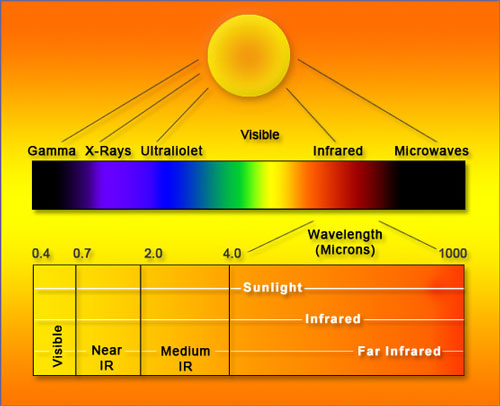
The reason why humans see different colors is because objects either absorb or don’t absorb these different light wavelengths, or frequencies, bouncing and reflecting off objects. The reason why you can see a red apple is because the organic compounds of the apple absorb every color but red.
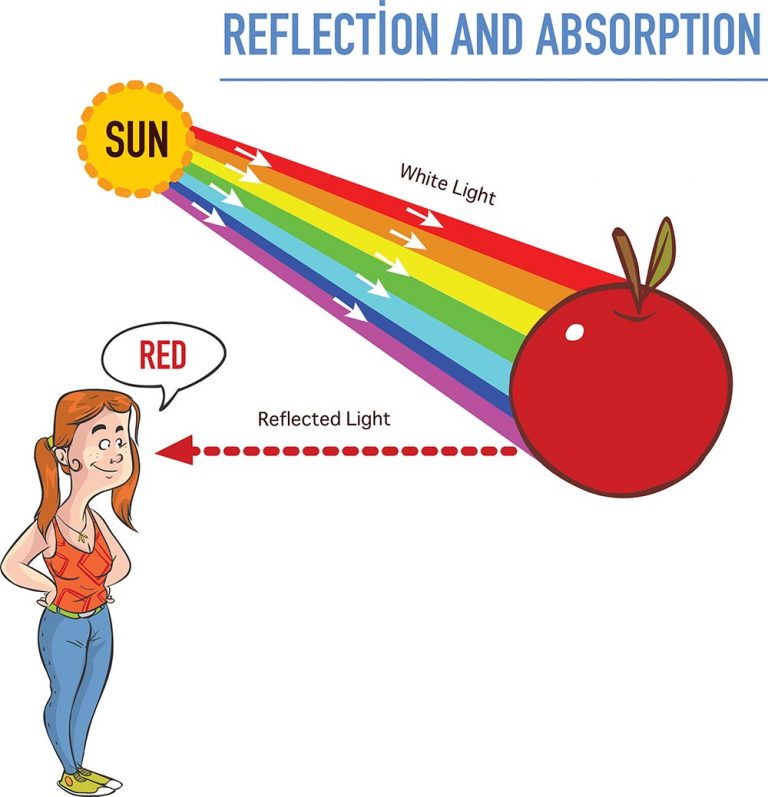
The last and longest wavelength (700 nanometers) visible to the human eye is red. After that, light is invisible to the human eye. This is where infrared light exists. “Infra-red” actually means “below red” as infra is the latin word for below.

Infrared light is invisible to humans, but it radiates energy which we feel as heat. Additionally, it can be focused and reflected just like visible light. It can even be harnessed and pointed at objects for them to absorb. The only difference is instead of seeing the wavelength (red color of the apple), your skin and body feel the heat.
Infrared light naturally comes from the sun. In fact, the sun’s energy consists of 50 percent infrared light at the level of Earth’s atmosphere. At ground level infrared energy accounts for 53 percent of light—we just can’t see it. But we feel it.
All types of light penetrate into objects, not just infrared. As this light is the right wavelength to produce heat, it will infiltrate an object and transfer its radiant energy. This energy is then absorbed by that object at the molecular level, causing the thermal motion of the object’s particles and electrons. In layman’s terms, the absorbed heat moves or charges the object’s molecules. As a result, the object’s core/internal temperature will increase based on the level of absorption of infrared heat.
Just as certain objects absorb different colors, as in our red apple example, objects have different organic properties which allow them to absorb different levels of infrared!
We understand heat as humans either from thermal radiation (infrared light), an object emitting heat into the air (convection) or by touching an object directly (conduction). Most of the time when you feel heat, you feel infrared. Almost all thermal radiation consists of infrared wavelengths, which means that all objects that emit heat also emit infrared.
This is my favorite example:
When you are walking outside on a hot summer day past a brick building in direct sunlight, if you put your hand a few inches away from the bricks but you don’t touch them, you still feel the radiant heat coming off of the brick—that’s infrared! The sun’s infrared light has actually heated the ceramic bricks from the inside (through absorption) and then the heat is released in the form of infrared light. You experience this light as heat. This is how infrared night vision works—It’s picking up on your radiant infrared energy.
Now that you understand what infrared light is, we can discuss how we harness it in the sauna environment.
The surface temperature of the heater is going to determine the infrared wavelength that is absorbed into your body. The longer the wave, the more that can be absorbed due to your body’s resonant frequency. We’ll get into why below.
There is a scientific principle that will give you the wavelength of infrared from a given object’s surface temperature called Wein’s law of displacement. Here is the formula:
5268 / ( temperature °F + 460) = the Peak Emission Wavelength (PEW) of an object (measured in microns)
PEW is the wavelength of infrared light that is measured in microns.
So what’s the best micron wavelength for your body to absorb in an infrared sauna? What will provide the maximum health benefits?
The short answer is 7.90 microns.
Now I’ll show you how we got there.
The most important factor for receiving health benefits in an infrared sauna is raising your core body temperature. The best surface temperature to heat your body and penetrate deep into your tissue is 200 °F. Here’s why:
5268 / (200 °F + 460) = 7.90 microns
As we see in the infrared light chart, the far infrared spectrum of light goes from 4 to 1000 microns.

It’s important to note that Wien’s Law formula is actually an inverse of surface temperature to wavelength. What that means is the hotter the surface temperature of an object, the shorter the wavelength. The opposite is true as well. As we get a higher micron level, the surface temperature drops and the wavelength becomes longer.
As you see on the infrared chart above, near infrared is represented in the infrared spectrum from .7 microns to 2.0 microns. Using Wein’s Law, this results in a surface temperature of 2150 °F – 7000 °F. The interior air temperature will obviously never get that hot in any infrared sauna, but in order to mathematically get the proper near infrared wavelength, the near infrared heater must get that hot.
The problem, besides the unreasonable heat requirement, is that the lower micron level does not help you attain the major health goals of infrared saunas—rest, weight loss and detoxification. It simply doesn’t penetrate deep enough into your body; it is also much, much too hot for an infrared sauna (2150 °F – 7000 °F). To find out more about near infrared in the infrared sauna environment, click here.
Mid infrared is represented from 2.0 to 4.0 microns and is still far too hot for an infrared sauna (2150 °F – 1100 °F).
Far infrared is where we start to find our sweet spot.
Our bodies are made up of over 70 percent water. Different molecules in your body are going to accept and absorb different infrared wavelengths. The water molecules in your body absorb a greater amount of far infrared than any other molecule. Water actually absorbs the highest amount of far infrared energy on the planet, and without water’s ability to absorb far infrared, we’d be in a continuous ice age.
The greater amount of infrared energy that your body receives, the greater the amount that will be absorbed by your body’s water molecules (and the greater the temperature). The different molecular types in your body are water, protein, connective tissue, fats and carbohydrates—98.7 of these are water molecules. Our bodies are literally designed to absorb far infrared energy.
So how does this apply to a far infrared sauna?
The objective of a far infrared sauna is to absorb far infrared energy and produce a deep and sustained sweat by whole body hyperthermia. In order to hit the body with the right temperature, you must heat the body by using an optimal wavelength of light (the Peak Emissive Wavelength) that results from the thermal radiation of an object (the surface temperature). This right wavelength is far infrared.
Far infrared saunas harness the potential heating properties of carbon and ceramic compounds at the molecular level by charging their inherent particles (making the molecules move faster than they already do, creating heat). Like any other object, the molecular properties of carbon and ceramic actually change when heated, and then absorb infrared energy which is released in the form of invisible light.
When you sit close to the infrared heat coming out of a carbon or ceramic infrared heater, your body then absorbs the infrared energy, thus charging your body’s particles and raising your core body temperature. The scientific principle which proves that heat turns into invisible light is called Wien’s Law of Displacement.
5268 / ( temperature °F + 460) = the Peak Emission Wavelength (PEW) of an object (measured in microns)
The reason why far infrared is the best for the sauna environment is because:
1. Far infrared is closer in wavelength to the PEW (wavelength) of the human body
2. It’s not too hot, allowing you to still be comfortable for 30 minutes or more
(Traditional saunas are usually in the 190 °F range which doesn’t allow for prolonged sweating and relaxation.)
When you put in a temperature into the above formula, what is produced is actually an inverse amount of heat to wavelength. The hotter the object’s temperature, the shorter or smaller the wavelength. The cooler the object’s temperature is, the longer the infrared wavelength. Let’s try a few temperatures.
5268 / ( 400 °F + 460) = 6.06 microns
5268 / ( 90 °F + 460) = 9.48 microns
The average skin temperature of a person is 90 °F. Because of the scientific principle of thermal radiation, we actually put out infrared in the same way that any other object emits infrared. So our Peak Emission Wavelength is 9.48 microns.
But wait, our bodies absorb infrared and put out infrared? Yes. Just like any object, when you are close enough to an object putting out infrared, your body will absorb it.
You can actually do a test right now to feel infrared: Put your hands together, but don’t make them touch—separate them about one inch apart. You will actually feel the infrared heat on the palms of your hands!
When your body absorbs infrared heat your core body temperature will rise as a result. The caveat is that the longer the infrared wave, the greater amount that your body can absorb. So, in the environment of an infrared sauna, knowing what we now know, how can we use objects to produce infrared in a small enough area to raise your core body temperature to produce a very deep sweat?
In order to have the discussion about which type of infrared heater is best, with the right wavelength, let’s bring it back to the basics and discuss the difference between traditional saunas and infrared saunas.

To further along our discussion to decide on which type of heater is best in the sauna environment, it’s important to discuss the difference between near and far infrared saunas. In order to get the near infrared band of light, you must heat an object to 2,150 °F, which is highly uncomfortable for most people to sit next to.
Uncomfortable enough that it would be physically impossible to surround yourself with near infrared heaters 360 degrees around you. This is why only one wall of the near infrared sauna can have the heater panel. Shall I repeat that temperature again? Because near infrared heaters are so hot, in a near infrared sauna there is only one side of the body being heated at a time.
Near infrared sauna enthusiasts claim that near infrared is much better for the skin. However, there is only one direction the near infrared light is coming from in a near infrared sauna; therefore, you have to continuously turn your body like a rotisserie to produce a full body sweat. Moreover, only a fraction of your skin is getting the infrared light waves. This is far from the even, enveloping, 360 degree heat of a far infrared sauna. Yes, you are essentially rotissering yourself.
Far infrared saunas actually came into existence much earlier than near infrared saunas. When it was discovered you could skip a step by heating your body directly, instead of the air and water between (like traditional saunas), it was by using the far infrared wavelength. (Why do you think people sit next to fires when it’s cold? Far infrared heat.)
The objective of an infrared sauna is to produce a deep and sustained sweat by raising your core body temperature. In order to raise your body’s temperature, you must heat the body by using the optimal wavelength of light that results from the thermal radiation of an object. This optimal wavelength is the far infrared band of light that is evenly distributed in an infrared sauna. Instead of your body seeing the light photons in the visible spectrum of light, your body feels these light photons as heat!
Far infrared is fantastic for many of the same things that near infrared is great for—a boost in metabolic rate, the burning fat cells, improved circulation, increasing cellular energy, faster skin rejuvenation, and faster cellular perfusion.
However, it is the far infrared wavelength that is much better in the infrared sauna environment.
I am in no way saying that near infrared doesn’t have therapeutic value; however, in the infrared sauna environment, it is less than ideal as it’s extremely inefficient in using infrared light waves, too hot and too uncomfortable (you have to sit on a stool that you can rotate–not a fixed ergonomic bench and backrest that you can sink into).
If you are certain you need near infrared, I would recommend a handheld near infrared LED light panel that you place directly on top of your skin outside of the sauna which will do the same thing a near infrared sauna does–bring blood to the surface of your skin to promote faster healing and pain relief.
Now that we have decided that far infrared is the better wavelength of infrared light to use in a sauna, let’s get into the discussion of carbon vs. ceramic heaters.
Ceramic compounds are quite pliable, which means they can be molded into many different states and shapes, including pottery or bricks for buildings. When ceramic compounds are heated, their electrons start to move quickly, generating intense heat. Ceramic material is a powerful conductor of energy with an emissivity rating that is nearly a full 1.0, higher than any other material. This high rating allows ceramic materials to absorb and radiate infrared better than any other material.
The main problem with a ceramic heater, however, is that it actually gets too hot. Ceramic heaters have surface temperatures between 350 and 400 °F. This is not ideal, because it leads to the air inside the sauna becoming so hot that most folks find it uncomfortable. And, as you’ll remember from our discussion of Wien’s Law, that surface temperature isn’t quite at the optimum level–200 °F–needed to create infrared waves of the perfect length for the body.
Carbon materials were a big development in infrared saunas, because as pliable as ceramics are, carbon is even more malleable, which meant that its surface area could be spread out and expanded. This expanded surface area is effective at lowering the surface temperature from ceramic’s roughly 350 °F to about 140 or 150 °F, which is actually a bit too cool when plugged into Wien’s formula above–it doesn’t create infrared waves that are in that perfect sweet spot of length–the kind that will give you the best health benefits.
The emissivity rating for carbon is also lower than ceramic, coming in at an average of .94 or .95. Simply put, carbon does not get hot enough to raise core body temperature on its own because it can’t hold as much infrared energy. Because of this, many sauna companies increase carbon panel surface area to generate more heat, which is effective at raising the air temperature in the sauna, but not as effective at emitting enough energy to really raise the core body temperature.
Now, what do you think would happen if you combined carbon and ceramic heaters? As you might guess (since one gets too hot at the surface and the other is too cool), that particular combo creates the most effective type of heater in the industry.
By mixing carbon and ceramic, you get a more emissive heater that has a surface temperature that won’t make the air in your sauna uncomfortable. You also get a combination effect that creates the perfect wavelength for penetrating deep into tissue and driving up a body’s core temperature, causing you to sweat and giving you amazing health benefits.
The emission rating of this material combination is .97, and the heater’s temperature is 200 °F, which gives us our ideal wavelength when plugged into the Wien’s Law of Displacement formula. Also, sitting near a heater with a surface temperature of 200 °F is a heck of a lot more comfortable than being near one that’s up around 400 °F.
Because of this, I really believe that the ideal surface temperature for a heater in an infrared sauna is 200 °F with infrared heaters pointing 100% of the infrared light at your body, 360 degrees around you. When you do this, your body has no choice but to absorb the infrared energy, raise your core temperature and produce a great sweat that will give you all of the great health benefits of whole body hyperthermia. When you combine these heaters with a very comfortable bench and backrest, you have the most effective and reliable way to improve your health for many years to come.
So there you have my reasoning for choosing the combination heaters (with the 200 °F surface temperature) over hot rock saunas, over near infrared saunas and over pure carbon or pure ceramic saunas. If you would like to read more about how the science behind infrared technology works, please refer to my book below ‘The Definitive Guide to Infrared Saunas’, or give me a call at (800) 370-0820 and I would be happy to walk you through everything.
I am glad infrared saunas have developed the way they have, because I couldn’t imagine my life without the benefits they provide, like deep sleep, lower blood pressure, less joint pain, weight loss, and a boosted immune system. Here at SaunaCloud I sell saunas that are some of the best history has offered. My far infrared saunas use advanced ceramic-carbon combination heaters for an amazing sauna experience. For more information on how SaunaCloud’s infrared saunas work and how they can improve your health, download my book The Definitive Guide to Infrared Saunas. Just give us a call at SaunaCloud 1.800.370.0820.
If you enjoyed this page, please share it below ↓ Thanks for reading,

Christopher Kiggins | Sauna Enthusiast
I have been writing, learning, educating and generally pointing people in the right direction infrared sauna wise since 2012. Let me know how I can help: chris@saunacloud.com - (530) 417-1220

